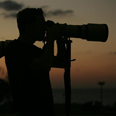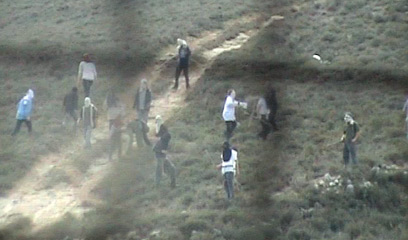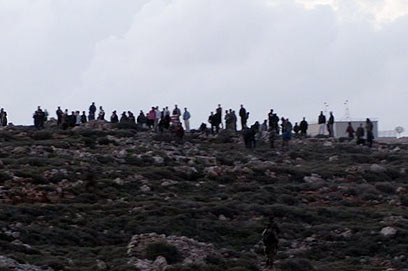
Conflict's new weapons
As both Right and Left realize potential of photographic evidence, cameras become ever-present feature at every clash, rally
As the sun rises above Mount Hebron Friday morning, two crowds gather at the entrance to a vineyard, ready for battle. On one side, a group of settlers, among them residents of Mount Sinai Farm. On the other, members of the Nawaja clan, reinforced by left-wing activists.
A fierce dispute over land ownership has broken out between the two populations ever since the settlers planted the grapevines on the site.
- Receive Ynetnews updates directly to your desktop
Curses and threats are exchanged as the tension reaches its peak, but IDF soldiers are nowhere to be found. Around 8 am, a leftist activist gives the cue, and dozens of Palestinian youths charge at the vineyard and begin to rip out the young seedlings.
Asher Alon, 30, adjusts his camera to an automatic setting, runs into the yard and begins shooting. Instead of trying to control the damage, he and his friends click the shutters over and over, documenting the havoc wreakers' every step.

Settlers throw stones in Yitzhar (Photo: B'Tselem)
Then, another set of cameras shows up, bearing the B'Tselem logo. Two stick-wielding settlers are immediately recorded on camera, from every possible angle. Ziyad Hamamra, a 26-year-old from as-Samu, takes nearly 300 pictures. As the settlers and Palestinian shove each other around, seven or eight cameras surround them, turning the vineyard into a media hub.
Armed with cameras
Over the past few years, the cameras have become an ever-present feature at every clash, razing and rally. As activists from the Left and the Right, Palestinians, policemen and soldiers tend to arrive armed to the battlefield – each side's claims are now backed with photographic proof.
The first ones to make operational use of cameras were the members of the leftist group B'Tselem. In 2006, they launched an initiative that armed hundreds of Palestinians with cameras, charging them with the task of taking pictures at conflict zones. That and the fact that almost every cell phone has a camera these days has turned each clash into a live broadcast.
In the first days of the project, one of the volunteers photographed a Jewish woman calling her neighbor "sharmuta" (slut). The video went viral and caused a stir around the world. After the incident, B'Tselem distributed cameras in other areas of the West Bank.
"The Israelis don't really believe the Palestinians," said Sarit Michaeli, one of the movement's leaders. "We realized that we need proof to back up the written statements."

Clashes during Alei Ain razing (Photo: Tazpit)
A few years later, the Right began to realize the potential of the camera as a weapon as well. Ten months ago, right-wing activist Amotz Eyal founded Tazpit (observation point), a photographic agency that aims to provide "national-religious counterbalance to the leftists groups' activity."
"This was our lesson from the Amona events," Eyal said, referring to the violent clashes that broke out when security forces razed the outpost in 2006. "There wasn't anyone to take pictures in preparation for the next day, no one to send materials to the media."
Eyal first obtained a donation of 20 cameras, which were distributed among local volunteers. The photos started streaming in, and Eyal began bombarding the media outlets' inboxes; the pictures are now often published alongside articles. The agency has recently launched a website as well.
'More cameras than rioters'
At first glance, Eyal looks like a member of the Meretz Youth movement; his blond hair is not covered by a skull cap, he drives a black motorcycle and wears a matching jacket. His hobbies are misleading as well; he plays football on a team that includes Palestinian players, he is addicted to terrain biking, and has founded a student village. He comes off as a member of the National Left, at best.
But Eyal, who is formerly religious, is a hardcore rightist activist. By the age of 24, he managed to found and volunteer in various organizations, petition the High Court of Justice a number of times, and march dozens of kilometers to the prime minister's house. A few years ago he took part in the battle for Gush Katif, during which he produced a CD with protest songs, and threw a trance music party titled "yes to trance, no to the transfer."
"It's difficult to find a framework to be a part of, because most of the frameworks were established by the rabbis and the Yesha Council," he says about being a secular individual in a largely religious movement. "During the disengagement, for example, the only non-religious protest was the trance party that I threw."
Eyal inherited the social activism bug from his father, Nahi Eyal, who founded the Legal Forum for the Land of Israel.
Ehud Amiton, 25, who was hurt during the Amona clashes, is yet another Tazpit activist. As a soldier, he was injured in a Palestinian riot in Hebron, and has had to use a walking stick since. For him, photographing the clashes is a mission.
"Unfortunately, the Arabs have more cameras than rioters," he says. "For every five protesters, they have 10 photographers."
'I release only what I see fit'
In addition to Tazpit's 40 volunteers, Eyal managed to recruit 40 photographers to the battle as well. "I don't receive edited materials from the volunteers, only raw ones, in order to prevent manipulation and preserve the credibility of the materials," he says.
Eyal claims that in many cases, the voluteers' photographs changed the picture. Recently, Jewish herders were arrested in Susya due to complaints from Palestinians who claimed that they were attacked. Tazpit photos were used in court, proving that the Jews were the ones attacked. As consequence, the suspects were released, and the complainants were arrested.
Moreover, during the razing of the Alei Ayin outpost, a Tazpit photographer documented an IDF officer instructing a soldier to throw a stone at someone, evidently a settler.
Eyal says that he only releases photographs that he sees fit to publish. "If I see no interest in releasing a certain material, I won't do it," he says. "The goal is to balance out the coverage of reality, therefore I decide what to publish, and what not to publish."
Michaeli, of B'Tselem, claims otherwise. "More than once, I have released documentation of Palestinians throwing stones," she says. If there is Palestinian violence, I definitely publish it."
According to Michaeli, the camera is a tool that can prevent bloodshed. "Sometimes, when people see cameras, they avoid violence," she says. "It deters the violent element, who realizes that everything is recorded. We would be very happy if our volunteers had nothing to do."
- Follow Ynetnews on Facebook










